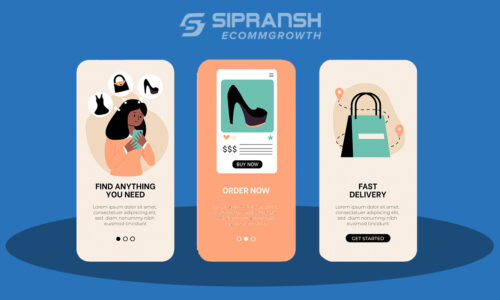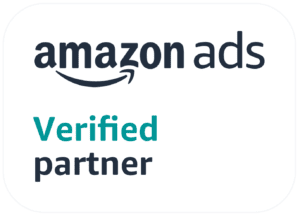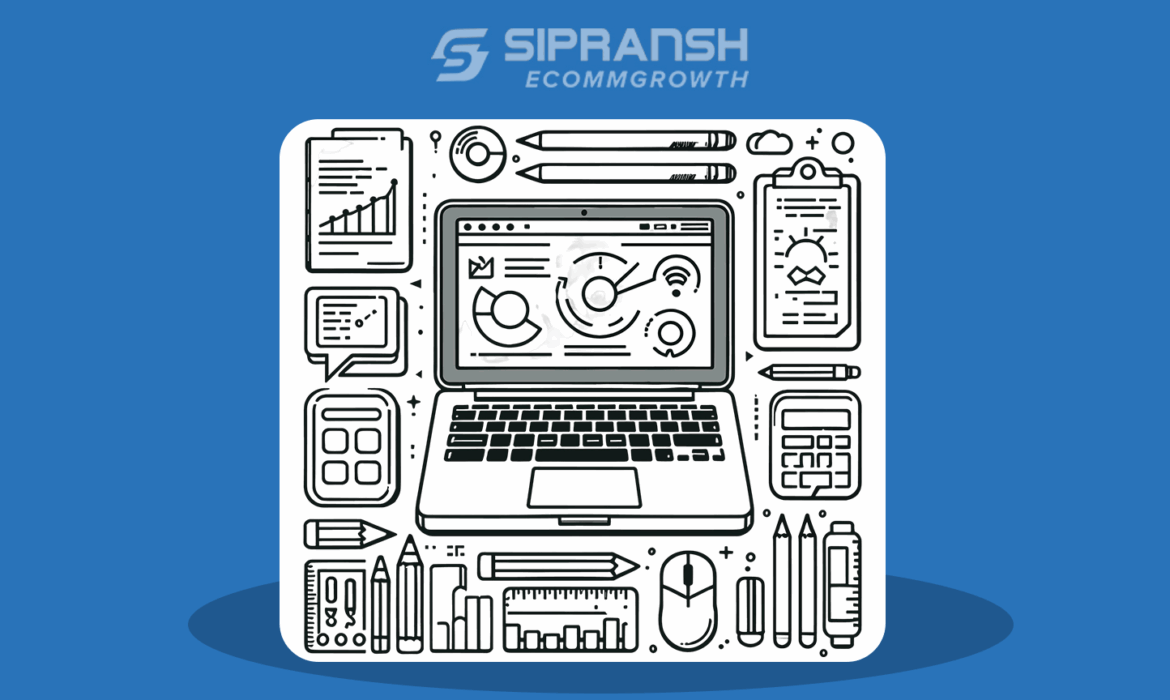
Ever noticed certain brands following you around online, on Amazon, news sites, and even inside your favorite mobile apps? That’s the power of Amazon DSP (Demand Side Platform) at work.
Most customers don’t buy the first time they visit a product page. They explore, compare options, get distracted, and often leave without purchasing. If you’re only using Sponsored Ads, you’re missing a major opportunity to bring those shoppers back. Amazon DSP helps you re-engage high-intent visitors by showing them your ads wherever they go online, nudging them closer to hitting “Buy Now.”
But it’s not just about running any ad—it’s about running smart, targeted ads at the perfect moment. In this guide, we’ll break down how Amazon DSP works, how to build effective retargeting campaigns, and how to expand your brand’s reach beyond search-based advertising.
What is Amazon DSP, and How Does It Work?
Amazon DSP (Demand Side Platform) is a powerful advertising solution that enables brands to run display and video ads across both Amazon-owned properties and external sites. Unlike Sponsored Ads, which rely on shoppers actively searching, DSP reaches users who have shown interest, even if they’re no longer on Amazon.
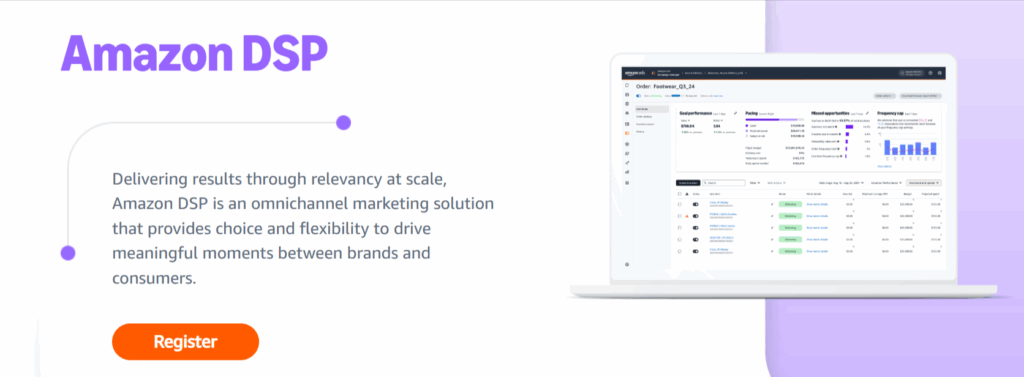
How Does It Work?
Amazon DSP taps into Amazon’s rich pool of shopper data to deliver highly targeted ads based on:
- Shopping behavior
- Demographic profiles
- Interests and browsing history
Here’s what Amazon DSP does behind the scenes:
- Tracks shopper behavior
- If someone views your product but leaves without buying, DSP keeps a record of that action.
- Displays your ad across multiple channels
- Ads can appear on platforms like:
- Amazon.com
- Fire TV
- Twitch
- IMDb
- Thousands of third-party websites and mobile apps
- Ads can appear on platforms like:
- Re-engages potential buyers
- When the shopper sees your ad again elsewhere, they’re reminded of your product, boosting the chance they’ll return and make a purchase.
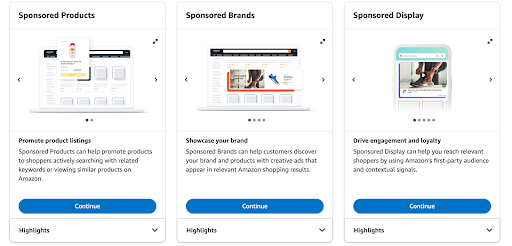
How Is Amazon DSP Different from Sponsored Ads?
Amazon offers multiple advertising solutions, but understanding the difference between Sponsored Ads and Amazon DSP is key to choosing the right one or combining both effectively.
Where Ads Appear
- Sponsored Ads:
- Shown only within Amazon, including:
- Search results
- Product detail pages
- The Buy Box
- Shown only within Amazon, including:
- Amazon DSP:
- Displays ads on and off Amazon, such as:
- Third-party websites
- Fire TV
- Twitch
- Mobile apps
- IMDb
- Displays ads on and off Amazon, such as:
Targeting Capabilities
- Sponsored Ads:
- Targets based on:
- Keywords
- Product categories
- Competitor ASINs
- Targets based on:
- Amazon DSP:
- Uses behavioral targeting, including:
- Shoppers who viewed your product
- Customers who added to the cart but didn’t purchase
- Buyers of related or similar items
- Uses behavioral targeting, including:
Campaign Control & Setup
- Sponsored Ads:
- Fully manual setup:
- You control bidding
- Adjust targeting
- Optimize campaigns manually
- Fully manual setup:
- Amazon DSP:
- Uses automated data-driven optimization:
- Leverages Amazon’s audience insights
- Targets high-intent users at scale
- Uses automated data-driven optimization:
Ad Formats
- Sponsored Ads:
- Limited to:
- Sponsored Products
- Sponsored Brands
- Sponsored Display
- Limited to:
- Amazon DSP:
- Offers rich media formats:
- Display banners
- Video ads
- Dynamic retargeting ads
- Offers rich media formats:
Budget & Accessibility
- Sponsored Ads:
- Open to all sellers
- No minimum spend required
- Amazon DSP:
- Typically requires a larger budget (often $10K or more)
- Best for brands looking to scale and expand reach
Which One Should You Use?
- Want fast visibility and conversions? → Go with Sponsored Ads
- Want to recover abandoned carts and reach users on Amazon? → Use Amazon DSP
- Want full-funnel coverage? → Combine both to maximize performance
Who can use Amazon DSP? Do I need to be a brand-registered seller?
Amazon DSP is not limited to Amazon sellers. It’s available to a broader range of advertisers, including:
- Amazon sellers (FBA or FBM)
- Vendors (selling directly to Amazon)
- Non-Amazon businesses
- Agencies and media buyers handling multiple accounts
Do You Need Brand Registry?
- No, Amazon DSP does not require Brand Registry
- However, Brand Registry offers added advantages:
- Access to Brand Analytics
- Better creative customization for ads
- Stronger brand recognition, enhancing retargeting performance
Even if you’re not selling on Amazon, you can still run ads targeting Amazon shoppers across Amazon’s extended network using Amazon DSP.
Is Amazon DSP only for big brands, or can small sellers use it too?
Amazon DSP is often seen as a tool for major brands because of its higher budget threshold. However, small and mid-sized sellers can also tap into its power, with the right strategy and support. While Amazon typically manages DSP for larger advertisers with a minimum spend of $50,000, smaller businesses can still participate by working with a certified Amazon DSP partner or agency.
How Can Smaller Sellers Access Amazon DSP?
Small sellers can still leverage DSP effectively by taking these steps:
- Partner with an Amazon DSP agency
- Many agencies offer managed DSP services with significantly lower budget requirements, often starting between $5,000 and $10,000, instead of Amazon’s standard minimum.
- Start with retargeting campaigns
- Rather than spending heavily on brand awareness, focus on:
- Shoppers who viewed your listings
- Cart abandoners
- Lookalike audiences similar to your existing customers
- Rather than spending heavily on brand awareness, focus on:
- Use DSP to scale proven winners
- If you have well-performing Sponsored Ads, DSP can amplify your best products and expand reach to off-Amazon channels, increasing sales without relying solely on Amazon search.
Is Amazon DSP Worth It for Small Sellers?
- If your PPC campaigns are optimized and delivering results, DSP can be a powerful way to grow beyond Amazon’s ecosystem.
- However, if your Sponsored Ads aren’t performing well yet, it’s wise to refine your ad strategy first before investing in DSP.
How much does Amazon DSP cost?
Amazon DSP isn’t a low-cost solution like Sponsored Ads. Here’s what to know:
- Direct from Amazon: Minimum spend is usually $50,000+
- Through a DSP agency: Budgets can start at around $5,000–$10,000
- Best for sellers ready to scale, not ideal for testing a brand-new product
Amazon DSP- Cost, Management Options, and Performance Timeline
When it comes to Amazon DSP, one size doesn’t fit all. Whether you’re a large brand or a growing seller, how you access and manage your DSP campaigns can affect everything, from your budget to results.
Amazon-Managed DSP (Ideal for Big Brands)
- Minimum spend: Typically $50,000+ (can vary by region and campaign goals)
- Campaign management: Fully managed by Amazon’s internal advertising team
- Best suited for: Enterprise-level brands looking for a hands-off, full-service approach
Agency-Managed DSP (Great for Mid-Sized and Small Sellers)
- Minimum spend: Generally between $5,000–$15,000 (varies by agency)
- Budget flexibility: More control over how funds are allocated
- Support: Agencies handle campaign setup, targeting, optimization, and reporting
- Ideal for: Brands that want expert help without Amazon’s steep entry point
What Influences the Cost of Amazon DSP?
Several key factors determine your DSP campaign expenses:
- Ad placement types
- Premium formats like video and homepage placements cost more than standard display ads.
- Targeting strategy
- Retargeting campaigns are generally more cost-efficient than prospecting new audiences.
- Industry competition
- In saturated categories, higher bids are required to secure impressions.
How Is DSP Pricing Structured?
Unlike Sponsored Ads, which operate on a Cost-Per-Click (CPC) model, Amazon DSP uses Cost-Per-Thousand Impressions (CPM). This means:
- You pay for views, not clicks
- Effective targeting and compelling creatives are essential to drive results and avoid wasted budget
How long does it take to see results with Amazon DSP?
Amazon DSP isn’t built for overnight success. Because it’s designed for retargeting and audience building, you can expect:
- 2 to 4 weeks to start seeing noticeable performance improvements
- A longer learning curve compared to Sponsored Ads
What Impacts the Timeline for DSP Results?
Several elements affect how quickly your DSP campaign gains traction:
- Type of campaign
- Retargeting campaigns typically perform faster than prospecting ones.
- Budget size and reach
- Bigger budgets lead to faster data collection and better optimization cycles.
- Ad frequency
- Buyers often need to see an ad multiple times before converting. Low frequency can delay results.
- Optimization phase
- Campaigns need time to learn and adapt, adjusting bids, creatives, and audiences for better performance.
When to Evaluate Your Amazon DSP Campaign
- Weeks 1–2: Data collection and audience testing begin
- Weeks 3–4: Optimization kicks in—expect improvements in conversion rates and ROAS
- Week 6 and beyond: Campaigns stabilize, and you can start scaling effective ad segments
Without proper experience, managing DSP on your own can lead to inefficient spending and underperformance. That’s why many sellers prefer working with experienced Amazon advertising agencies who can optimize campaigns for better returns and lower upfront costs.
Can I run Amazon DSP ads myself, or do I need an Amazon PPC management agency?
Unlike Sponsored Ads, which sellers can easily manage through Seller Central, Amazon DSP is typically not self-service for most sellers. There are two main options for accessing Amazon DSP:
1. Amazon-Managed DSP (For Large Advertisers)
- Minimum budget: Starts at $50,000 or more
- Management: Fully handled by Amazon’s in-house advertising team
- Control: Limited flexibility, as Amazon oversees campaign structure, optimizations, and reporting
- Best for: Large companies with substantial ad budgets seeking a fully managed solution
2. Agency-Managed DSP (For Small and Medium-Sized Businesses)
- Minimum budget: Typically between $5,000 and $15,000 (varies by agency)
- Flexibility: Greater control over targeting and campaign strategy
- Support: Agencies offer hands-on management, strategy customization, and transparent performance reports
- Best for: Smaller brands wanting expert assistance without the high minimum investment required by Amazon
Can You Manage Amazon DSP Yourself?
While Amazon DSP does offer a self-service model, it is only available to approved advertisers and requires advanced knowledge of programmatic advertising. Running DSP independently means taking on responsibilities such as:
- Building and refining audience targeting strategies
- Managing bids and pacing to maintain efficiency
- Analyzing performance data and optimizing creatives
- Allocating budgets across ad placements and formats
Without proper experience, managing DSP on your own can lead to inefficient spending and underperformance. That’s why many sellers prefer working with an experienced Amazon advertising agency that can optimize campaigns for better returns and lower upfront costs.
What are the common mistakes sellers make with Amazon DSP?
- Launching DSP Without First Optimizing Sponsored Ads
Amazon DSP is most effective when used to amplify products that already perform well through Sponsored Ads. If your current ad campaigns aren’t profitable, focus on refining those before allocating budget to DSP. Using DSP to fix underperforming products often leads to wasted ad spend. - Poor Audience Segmentation
A common issue is targeting overly broad groups rather than narrowing in on high-intent customers. It’s more effective to begin with retargeting campaigns, such as engaging cart abandoners or recent product viewers, before expanding to broader audience segments. - Relying on a Single Ad Creative
Limiting your campaign to just one creative type or message reduces your chances of reaching diverse customer preferences. To improve engagement, test various formats, including static images, videos, and dynamic content, to identify what resonates most with your audience. - Neglecting Frequency Capping
Running ads too often can cause ad fatigue, while insufficient exposure may result in low brand recall. Establishing a balanced frequency, typically between three to five impressions per user each week, helps maintain visibility without overwhelming potential buyers. - Focusing Only on ROAS
While Return on Ad Spend is a key performance metric, it shouldn’t be the only focus. Brands should also track new-to-brand conversions, brand lift, and customer retention. These insights offer a more comprehensive view of campaign impact and long-term value. - Failing to Exclude Irrelevant Audiences
Without proper negative targeting, ads might be shown to users who have already made a purchase, leading to unnecessary costs. To improve efficiency, make sure to exclude past buyers from your retargeting campaigns. - Expecting Quick Results
Unlike Sponsored Ads, DSP campaigns require time to gather data, optimize targeting, and test creatives. It’s typical to wait two to four weeks before seeing consistent results. Allow your campaigns time to mature, and use data trends to inform ongoing adjustments.
Ready to elevate your Amazon advertising strategy?
If your goal is to grow efficiently and boost the return on your ad investments, partnering with experienced Amazon consultants can provide the strategic insight needed to refine your DSP campaigns, improve audience targeting, and get the most from every advertising dollar.
Don’t let your competitors get ahead. Start using Amazon DSP now and convert missed opportunities into measurable results.



